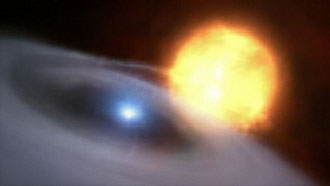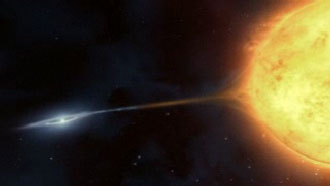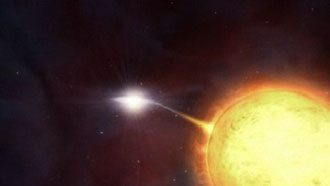Ticking Stellar Time Bomb Identified
|
|
Using ESO’s Very Large Telescope and its ability to obtain images as sharp as if taken from space, astronomers from the University of Warwick and the University of Manchester have made the first time-lapse movie of an unusual shell of matter ejected by a “vampire star.” See the time-lapse video.
The ‘vampire star,’ known as V445 in the constellation of Puppis (‘the Stern’), has been gulping down gas from its close companion star eventually causing it to undergo a nova explosion, becoming 250 times brighter than before and ejecting a large quantity of matter into space.
This enabled a team of astronomers, including UK researchers from the University of Warwick and the University of Manchester, to study V445 Puppis in great detail and determine the distance and intrinsic brightness of the outbursting object. The Science and Technology Facilities Council funds UK membership of ESO, allowing our astronomers access to its telescopes to carry out their research.
From the findings, in the 20 November edition of the Astrophysical Journal, it appears that this double star system is a prime candidate to be one of the long-sought progenitors of the exploding stars known as Type Ia supernovae, critical for studies of the mysterious dark energy.
V445 Puppis is the first, and so far only, nova appearing to have no hydrogen. It provides the first evidence for an outburst on the surface of a white dwarf [1] dominated by helium. Dr Danny Steeghs, from the University of Warwick, one of the key team members and co-author of the paper, said: “This is critical, as we know that Type Ia supernovae lack hydrogen and the companion star in V445 Pup fits this nicely by also lacking hydrogen, instead dumping mainly helium gas onto the white dwarf.”
The team of astronomers used the NACO adaptive optics instrument [2] on ESO’s Very Large Telescope (VLT) to obtain very sharp images of V445 Puppis over a time span of two years following its November 2000 outburst. The images show a bipolar shell, initially with a very narrow waist, with lobes on each side. Two knots are also seen at both the extreme ends of the shell, which appear to move at about 30 million kilometres per hour. The shell — unlike any previously observed for a nova — is itself moving at about 24 million kilometres per hour. A thick disc of dust, which must have been produced during the last outburst, obscures the two central stars.
“The incredible detail that we can see on such small scales — about hundred milliarcseconds, which is the apparent size of a one euro coin seen from about forty kilometres — is only possible thanks to the adaptive optics technology available on large ground-based telescopes such as ESO’s VLT,” added Dr Steeghs.
A supernova is one way that a star can end its life, exploding in a spectacular display of fireworks. One family of supernovae, called Type Ia supernovae, are of particular interest in cosmology as they can be used as “standard candles” to measure distances in the Universe [3] and so can be used to calibrate the accelerating expansion that is driven by dark energy.
Type Ia supernovae are thought to result from the explosions of white dwarfs, super-dense dead stars about the size of the Earth which were once the core of stars like the Sun and whose outer layers have been lost into space.
One defining characteristic of Type Ia supernovae is the lack of evidence for hydrogen in the light they produce. Yet hydrogen is the most common chemical element in the Universe. Such supernovae most likely arise in systems composed of two stars, one of them being a white dwarf. When such white dwarfs, acting as stellar vampires that suck matter from their companion, become heavier than a given limit, they become unstable and explode [4].
Co author of the paper Dr Tim O’Brien, of The University of Manchester’s Jodrell Bank Centre for Astrophysics continued: “As the white dwarf feeds on its companion, the captured gas accumulates on its surface until thermonuclear reactions begin, causing a massive explosion which ejects matter out into space at phenomenal speeds.”
Once the outburst is over, gas will again build up on the white dwarf until at some point in the future, V445 Pup should explode again. The crucial question is whether, by holding onto some of the cannibalised matter from its companion, the white dwarf manages to gain weight after each cycle of gorging and explosive outburst.
As Dr O’Brien explains: “If the white dwarf is increasing in mass then it will eventually reach a point where it will be ripped apart in a titanic supernova explosion and its cycle of outbursts will come to an end.”
Combining the NACO images with data obtained with several other telescopes [5] the astronomers could determine the distance of the system — about 25,000 light-years from the Sun — and its intrinsic brightness — over 10,000 times brighter than the Sun. This implies that the vampire white dwarf in this system has a high mass that is near its fatal limit and is still simultaneously being fed by its companion at a high rate.
Dr Patrick Woudt, from the University of Cape Town and lead author of the paper reporting the results said: “One of the major problems in modern astrophysics is the fact that we still do not know exactly what kinds of stellar system explode as a Type Ia supernova. As these supernovae play a crucial role in showing that the Universe’s expansion is currently accelerating, pushed by a mysterious dark energy, it is rather embarrassing. Whether V445 Puppis will eventually explode as a supernova, or if the current nova outburst has pre-empted that pathway by ejecting too much matter back into space is still unclear. But we have here a pretty good suspect for a future Type Ia supernova!”
Notes
[1] White dwarfs represent the evolutionary end product of stars with initial masses up to a few solar masses. A white dwarf is the burnt-out stellar core that is left behind when a star like the Sun shreds its outer layers towards the end of its active life. It is composed essentially of carbon and oxygen. This process normally also leads to the formation of a surrounding planetary nebula.
[2] Adaptive optics is a technique that allows astronomers to obtain an image of an object free from the blurring effect of the atmosphere. See the adaptive optics page at ESO: http://www.eso.org/public/astronomy/technology/adaptive_optics.html
[3] See for example http://www.eso.org/~bleibund/papers/EPN/epn.html
[4] This Chandrasekhar limit, named after the Indian physicist Subrahmanyan Chandrasekhar, is nearly 1.4 times the mass of the Sun. When a white dwarf reaches a mass above this limit, either by sucking matter from a companion or merging with another white dwarf, it will turn itself into a thermonuclear bomb that will burn carbon and oxygen explosively.
[5] The team also used the SOFI instrument on ESO’s New Technology Telescope, the IMACS spectrograph on the 6.5-metre Magellan Baade telescope, and the Infrared Survey Facility and the SIRIUS camera at the Sutherland station of the South African Astronomical Observatory.
More Information
This research was presented in a paper to appear in the 20 November 2009 issue of the Astrophysical Journal, vol. 706, p. 738 (“The expanding bipolar shell of the helium nova V445 Puppis”, by P. A. Woudt et al.). A copy of the research paper can be accessed via http://arxiv.org/abs/0910.1069
The team is composed of P. A. Woudt and B. Warner (University of Cape Town, South Africa), D. Steeghs and T. R. Marsh (University of Warwick, UK), M. Karovska and G. H. A. Roelofs (Harvard-Smithsonian Center for Astrophysics, Cambridge MA, USA), P. J. Groot and G. Nelemans (Radboud University Nijmegen, the Netherlands), T. Nagayama (Kyoto University, Japan), D. P. Smits (University of South Africa, South Africa), and T. O’Brien (University of Manchester, UK).
Contacts:
Dr Danny Steeghs, University of Warwick T: +44 (0)2476 573873 E: D.T.H.Steeghs@warwick.ac.uk
Karen Coles Press Officer Science and Technology Facilities Council T: +44 (0)1925 603232 E: Karen.coles@stfc.ac.uk
Dr. Tim O’Brien Jodrell Bank Centre for Astrophysics, University of Manchester T: +44 (0)161 275 4165 E: tim.obrien@manchester.ac.uk
European Space Observatory
ESO, the European Southern Observatory, is the foremost intergovernmental astronomy organisation in Europe and the world’s most productive astronomical observatory. It is supported by 14 countries: Austria, Belgium, the Czech Republic, Denmark, France, Finland, Germany, Italy, the Netherlands, Portugal, Spain, Sweden, Switzerland and the United Kingdom. ESO carries out an ambitious programme focused on the design, construction and operation of powerful ground-based observing facilities enabling astronomers to make important scientific discoveries. ESO also plays a leading role in promoting and organising cooperation in astronomical research. ESO operates three unique world-class observing sites in Chile: La Silla, Paranal and Chajnantor. At Paranal, ESO operates the Very Large Telescope, the world’s most advanced visible-light astronomical observatory. ESO is the European partner of a revolutionary astronomical telescope ALMA, the largest astronomical project in existence. ESO is currently planning a 42-metre European Extremely Large optical/near-infrared Telescope, the E-ELT, which will become “the world’s biggest eye on the sky”.
Science and Technology Facilities Council
The Science & Technology Facilities Council ensures the UK retains its leading place on the world stage by delivering world-class science; accessing and hosting international facilities; developing innovative technologies; and increasing the socio-economic impact of its research through effective knowledge exchange partnerships. The Council has a broad science portfolio including Astronomy, Particle Physics, Particle Astrophysics, Nuclear Physics, Space Science, Synchrotron Radiation, Neutron Sources and High Power Lasers. In addition the Council manages and operates three internationally renowned laboratories:
• The Rutherford Appleton Laboratory, Oxfordshire
• The Daresbury Laboratory, Cheshire
• The UK Astronomy Technology Centre, Edinburgh
The Council gives researchers access to world-class facilities and funds the UK membership of international bodies such as the European Laboratory for Particle Physics (CERN), the Institute Laue Langevin (ILL), European Synchrotron Radiation Facility (ESRF), the European organisation for Astronomical Research in the Southern Hemisphere (ESO) and the European Space Agency (ESA). It also contributes money for the UK telescopes overseas on La Palma, Hawaii, Australia and in Chile, and the MERLIN/VLBI National Facility, which includes the Lovell Telescope at Jodrell Bank Observatory.
Peter Dunn, Head of Communications
Communications Office, University House,
University of Warwick, Coventry, CV4 8UW, United Kingdom
email: p.j.dunn@warwick.ac.uk
Tel: +44 (0)24 76 523708 Mobile/Cell: +44 (0)7767 655860
PR131 17th November 2009




